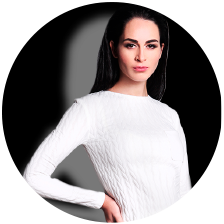
In her author’s YouTube show, Victoria Fainblat, an architect and interior designer, showed her viewers the house of the future Intelcity company.
More details
Victoria Fainblat, an architect and interior designer, showed her viewers the house of the future company Intelcity, talked about an intelligent butler, voice control using Siri and Alexa, smart light that will help preserve our health and the health of our children.
“Robots are becoming more and more integrated into our daily life every day. Sooner or later we will lie on the couch and watch them do all the work for us.
New technologies are moving forward at a crazy pace and we could not help but come to this place. This is the only show house in all of Europe. Manufacturers of household appliances, lighting fixtures and many other things send their novelties here for testing. All this is controlled by the “smart home” system, which every day interests our consumers more and more ”.
Keys are not required to enter the smart home: instead, you need to go through an authentication system using a fingerprint, code or access card.
“Whatever you integrate into your home, you need to manage it somehow. The easiest way is Amazon Alexa voice assistant. You can also control these systems using your phone, tablet, watch or mechanical wall control panel. ”
Victoria Fainblat: – I know that you have lighting that helps to preserve our health. It’s true?
Leonid Nikolaev: – Not only to preserve health, but also to increase labor productivity. For example, a child will be most comfortable doing homework at a lighting temperature of 4000 K. In this case, cortisol, an activity hormone, is produced, so all tasks are solved very quickly.
Victoria Fainblat: – How does it work?
Leonid Nikolaev: – This is a biodynamic light system that was developed in Europe and is already available in Ukraine. One of the main buyers of this system are software giants who have their offices in Ukraine and use it to improve the productivity of their programmers. I hope that sooner or later this system will be included in the state program in our country and such lighting will be widely used in medical and children’s institutions.
From our point of view and from the point of view of our European partners, the main task of artificial light is to compensate for the lack of natural light. It depends on your location, time of day, and therefore artificial light must change temperature and intensity over time.
Victoria Fainblat: – I know about the DALI system, tell us what it is?
Leonid Nikolaev: – In simple terms, the DALI system is the ability to control each lamp separately. For example, in a given room we have about 50 different lamps and naturally it is simply not physically possible to manually control each of them. In this case, the DALI protocol helps us very well: each luminaire has its own address and follows a common scenario.
“As you can see, there is an indicator of the temperature regime on all panels, it is very difficult to imagine that you do not need to separately control air conditioners, underfloor heating, because the“ smart home ”system does it for you: analyzes, gives commands and executes.
In everyday life, we always forget to turn something on or off, but an intelligent system can control this for you. This applies not only to water or household appliances, but also to climate control in the house. In other words, the air conditioner and the floor heating will never run at the same time. In the house of the future, all climate systems work in concert to create comfortable conditions where we are and economical conditions where we are not.
In a real smart home, the main source of heat is the sun. It is his energy that we must use to the maximum. and the task of the remaining heating systems is to compensate for the lack of natural heat. The most efficient system today is the radiant heating and cooling system, that is, the walls, floors and ceilings are the sources of heat and coolness. ”
Media












